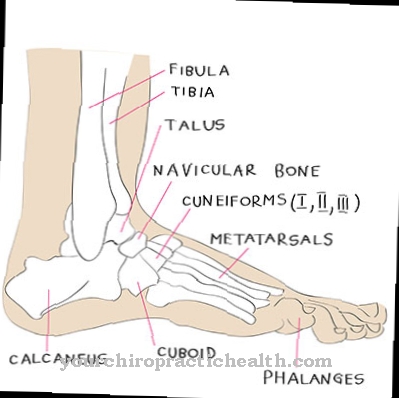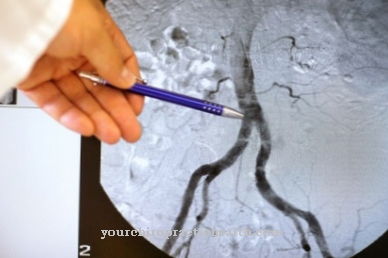In the Trisomy 22 it is a hereditary disease in which chromosome 22 is present three times. The disease leads to both cognitive and physical disabilities. Those affected can suffer from the restrictions to different degrees.
What is trisomy 22?
The Trisomy 22 is a genetic disease that leads to mental and physical impairment. The handicap can have different degrees of severity. A trisomy is caused by a failure in cell division. Normally human cells have a double (diploid) set of chromosomes in which every single chromosome is present twice. In a trisomy, however, the affected chromosome appears three times in the genome.
Medicine distinguishes between different subforms of trisomy 22:
- In the Free trisomy 22 All body cells have three 22nd chromosomes that are independent and clearly separated from each other.
- In the case of the Translocation trisomy 22 The extra chromosome shifts and connects to another. At first glance, the set of chromosomes therefore appears to have the correct number of chromosomes.
- In the Partial trisomy 22 only a section of a chromosome doubles. Correspondingly, this part (Latin “pars”) is available three times. Partial trisomy is visually characterized by the fact that one of the affected chromosomes is longer: it carries the additional part.
- People with a Mosaic trisomy in contrast, possess both trisome cells and disome cells; the trisomy is limited to just one cell line. Most of those affected have such a mosaic trisomy, as the probability of survival with this type is significantly higher than with other forms.
causes
Trisomy 22 is caused by an error in cell division. When a cell divides, one chromosome of each type normally migrates into one of the two halves of the cell. Immediately after division, the new cells therefore have a simple (haploid) set of chromosomes. Only then does the cell copy the genetic information so that there are again two chromosomes of each type. However, errors can occur in this process.
If the chromosomes do not split correctly between the two cell halves, one of them has one chromosome too many. Even so, the cell makes a copy of one of the chromosomes; In the finished cell there are therefore three chromosomes 22 instead of just two. Such errors in cell division can occur in both men and women. The cause of a trisomy 22 in the child can therefore lie equally with the father or the mother.
Symptoms, ailments & signs
The symptoms of trisomy 22 include both mental and physical impairments. The psychological symptoms primarily include cognitive impairments. For example, those affected may have a lower intelligence quotient (IQ). Cognitive impairments therefore show up in different areas of thinking.
With trisomy 22, especially the mosaic type, however, it depends a lot on how much the brain cells are affected by the trisomy. A heart defect manifests itself in around 50 percent of affected children. This is a malformation of the organ: The anatomical shape of the heart or its blood vessels has special features. They cause the heart to stop working properly or to tire prematurely.
Doctors therefore recommend regular observation even in the case of heart defects that do not pose an acute danger.Heart defects in trisomy 22 are just one of the possible organ damage. In mosaic trisomy 22 it depends on which cells of the organism are affected by the trisomy - the type and extent of the organic malformations also depend on this.
Diagnosis & course of disease
External physical features may be the first signs of trisomy 22. The affected children often have a wide skull and a high forehead. The face is often flat with wide-set eyes, low-set ears and a beak-shaped nose. The lower jaw typically protrudes. A genetic test can determine trisomy 22 beyond any doubt.
Complications
Trisomy 22 leads to many different limitations and symptoms. As a rule, those affected suffer from a number of different cognitive and motor disorders that cannot be treated directly. Mental retardation also occurs, so that the patients are dependent on the help of other people in their lives.
However, trisomy 22 can also lead to a heart defect, so that those affected can die of sudden cardiac death. The heart itself cannot work properly due to the malformation, so that patients quickly appear tired and exhausted. You are therefore dependent on regular examinations to avoid further complications.
However, other organs can also be damaged by the trisomy 22. The disease can also lead to aesthetic problems. The patients often do not feel beautiful and therefore suffer from reduced self-confidence or, in childhood, from bullying or teasing.
Since a causal therapy of trisomy 22 is not possible, only the individual complaints and symptoms of the disease can be alleviated. There are no complications. Relatives and parents are also often affected by the psychological complaints of the disease and therefore also need treatment.
When should you go to the doctor?
With trisomy 22, the affected person depends on a medical examination and treatment so that further complications can be prevented. In the worst case, if left untreated, this disease can lead to the death of the person affected, so that an early diagnosis with subsequent treatment always has a very positive effect on the further course of trisomy 22. Since it is also a genetic disease, genetic counseling should also be carried out if you want to have children.
A doctor should be contacted if the person concerned has significantly reduced intelligence. Heart problems or malformations all over the body can also indicate this disease and should be examined by a doctor. Quick fatigue or permanent fatigue can also indicate this disease.
As a rule, trisomy 22 is recognized by a pediatrician or a general practitioner. Further treatment depends on the exact complaints and is carried out by a specialist. In some cases, the life expectancy of those affected is also reduced by this disease. Not infrequently, parents and relatives are also dependent on psychological treatment.
Therapy & Treatment
Like all trisomies, trisomy 22 is incurable. The affected cells have three 22nd chromosomes from birth and cannot lose the additional chromosome. The treatment is therefore aimed primarily at the damage that occurs as a result of the mutation. The treatment can therefore look very different in individual cases.
Since heart defects are particularly common, medical therapy often focuses on the vital organ. Physiotherapy and occupational therapy usually support the treatment of physical disabilities. If children with trisomy 22 show severe behavioral problems, psychotherapeutic approaches can also be considered. They can also be useful if those affected suffer severely from the social or emotional consequences of the disability.
prevention
For the prevention of trisomy 22 and similar diseases, forward-looking family planning is an advantage. The older the child's mother is, the more likely it is for such mutations. Doctors consider an age of the mother of less than 35 years as relatively uncritical. In this age range, the risk of a trisomy is significantly lower.
Nevertheless, these are only probabilities: even a young mother's age is no guarantee that a trisomy or other genetic defects can be completely excluded. In mothers over 35, prenatal diagnostics may be useful, as children with trisomy 22 are often not born alive. The older the father's age also increases the risk of a trisomy in the child.
Aftercare
Since the clinical picture of trisomy 22 is very different, individually adapted follow-up care is required. The aftercare measures are about observing the peculiarities associated with the chromosomal disorder and, if necessary, initiating treatment of problems if these can be reduced as a result. In most cases, cognitively impaired patients benefit from lifelong support measures initiated at an early stage.
Limitations of the musculoskeletal system and motor skills can be improved as part of aftercare through physical or occupational therapy. The heart defects that occur in roughly every second person affected require close monitoring even after the actual treatment. In this way, deterioration can be detected at an early stage and the treating cardiologist can take appropriate measures if necessary.
Aftercare also includes looking after relatives. The parents of children with trisomy 22 must be supported in such a way that they can manage the child in the best possible way. If necessary, psychological help can be useful. After a woman has given birth to a child with trisomy 22, human genetics can be used to determine whether there is an increased risk of recurrence.
During a subsequent pregnancy, prenatal diagnostics can provide information about whether the child is affected again. However, the risks of invasive diagnostic measures should not be ignored.
You can do that yourself
Trisomy 22 from the group of hereditary diseases is not curable, but there are self-help and support options with which the quality of life can be sustainably increased.
Because of the heart defect, it is important to eat a healthy diet. In particular, avoiding overeating and foods containing cholesterol has a positive effect. Excessive sport is not allowed, but casual running in the fresh air is recommended. A regular check of the heart must be done by a specialist several times a year. Occupational therapy and physiotherapy provide a remedy for the treatment of motor impairments, in particular it serves to maintain existing abilities and skills. Specially trained motologists help to experience the body's own limits and to build a positive relationship with it.
Psychotherapeutic treatment is indicated to accompany and support in everyday life. Emotional and social stress factors are identified and resolved in a protected environment. Conversational and behavioral psychotherapy is particularly suitable for this. Systemic psychotherapy has a positive effect on problems that affect the social and family environment. A broad social environment with various contact points has a positive effect. Self-help groups offer a place where experiences are exchanged and further information and help options are offered.

.jpg)




.jpg)




















